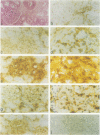Abstract
OBJECTIVE: This study examined antigen-independent factors in the pathogenesis of chronic rejection of organ transplants. SUMMARY BACKGROUND DATA: In addition to alloantigen-dependent events, antigen-independent factors can influence chronic rejection of organ allografts. Initial injury, including early ischemia and acute rejection, may contribute. METHODS: Kidney isografts were transplanted orthotopically into bilaterally nephrectomized rat recipients and studied functionally, morphologically and immunohistologically, at serial intervals up to 72 weeks after transplantation. Controls included chronically rejecting kidney allografts using a well-established model, non-nephrectomized and uninephrectomized animals with a native kidney that had undergone initial ischemia and uninephrectomized rats whose remaining kidney had been manipulated operatively. RESULTS: Allograft recipients developed progressive proteinuria after 12 weeks, with gradual renal failure ultimately leading to death. At the same time, morphologic changes, including progressive arteriosclerosis and glomerulosclerosis, tubular atrophy, and interstitial fibrosis, developed. Immunohistologically, macrophages infiltrated glomeruli during this period and cytokines became upregulated. Comparable changes occurred in isografts, but later, beginning after week 24 and progressing thereafter. The single ischemic kidney in uninephrectomized controls also developed the same lesions; no comparable changes were noted in other control kidneys. CONCLUSIONS: Antigen-independent functional and morphologic changes occur in long-term kidney isografts that resemble those appearing considerably earlier in allografts that reject chronically. Initial injury and extent of functioning renal mass may be important factors for such late changes.
Full text
PDF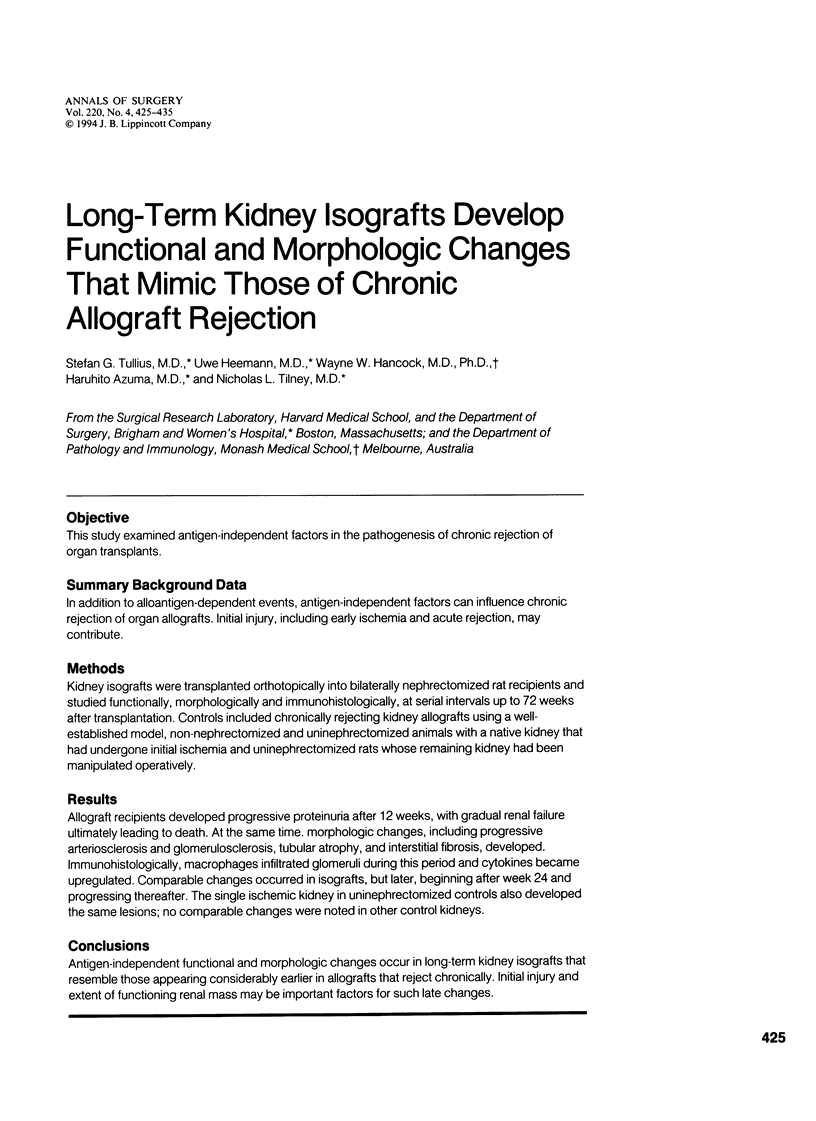
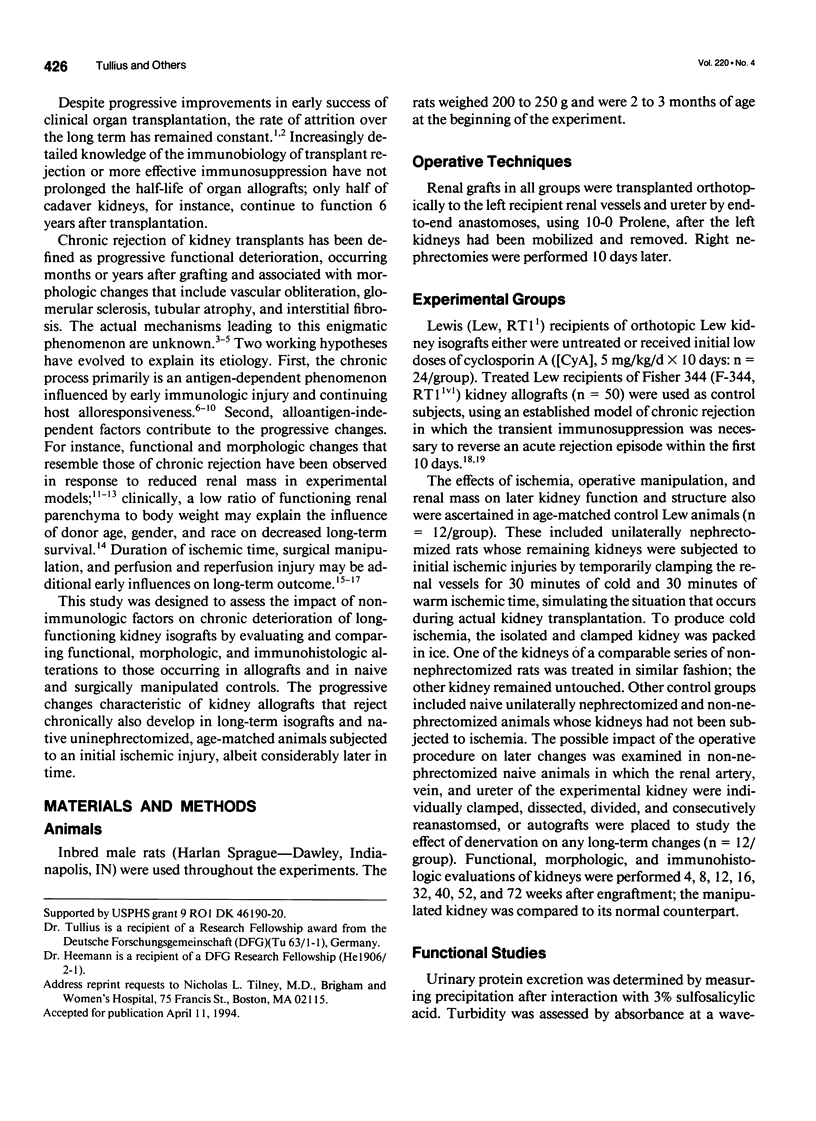
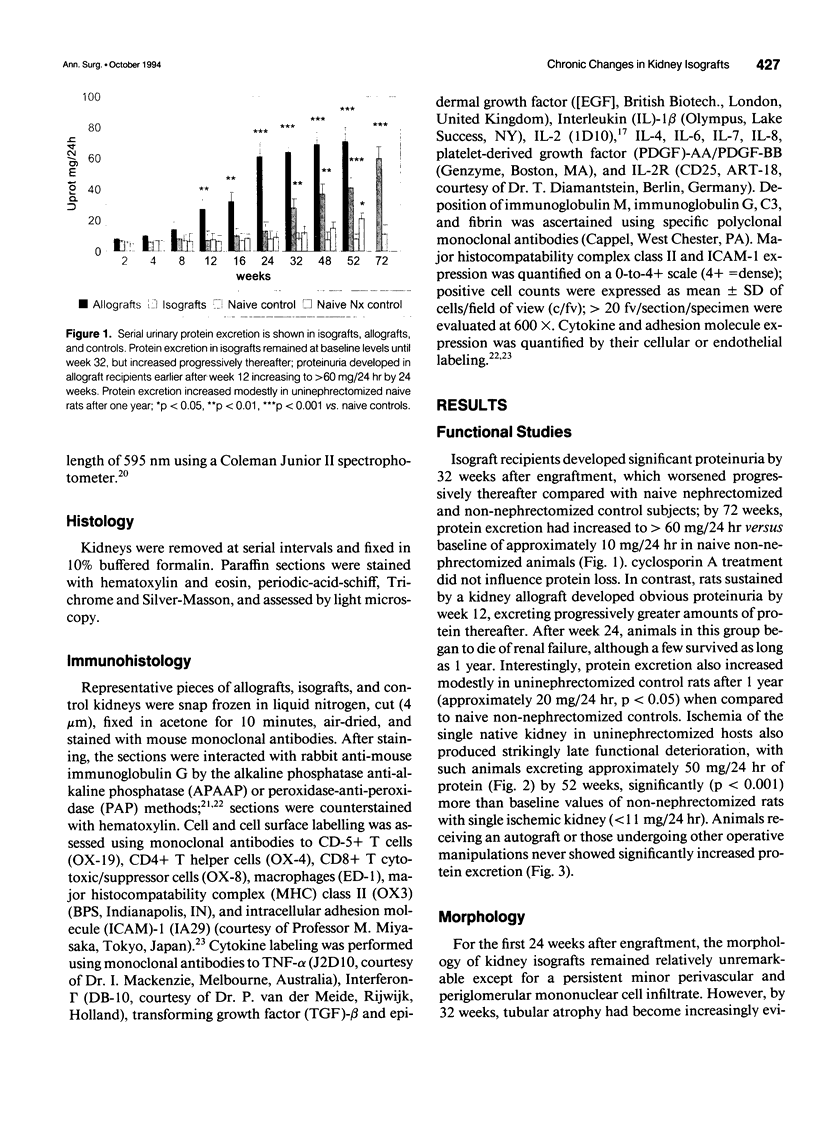
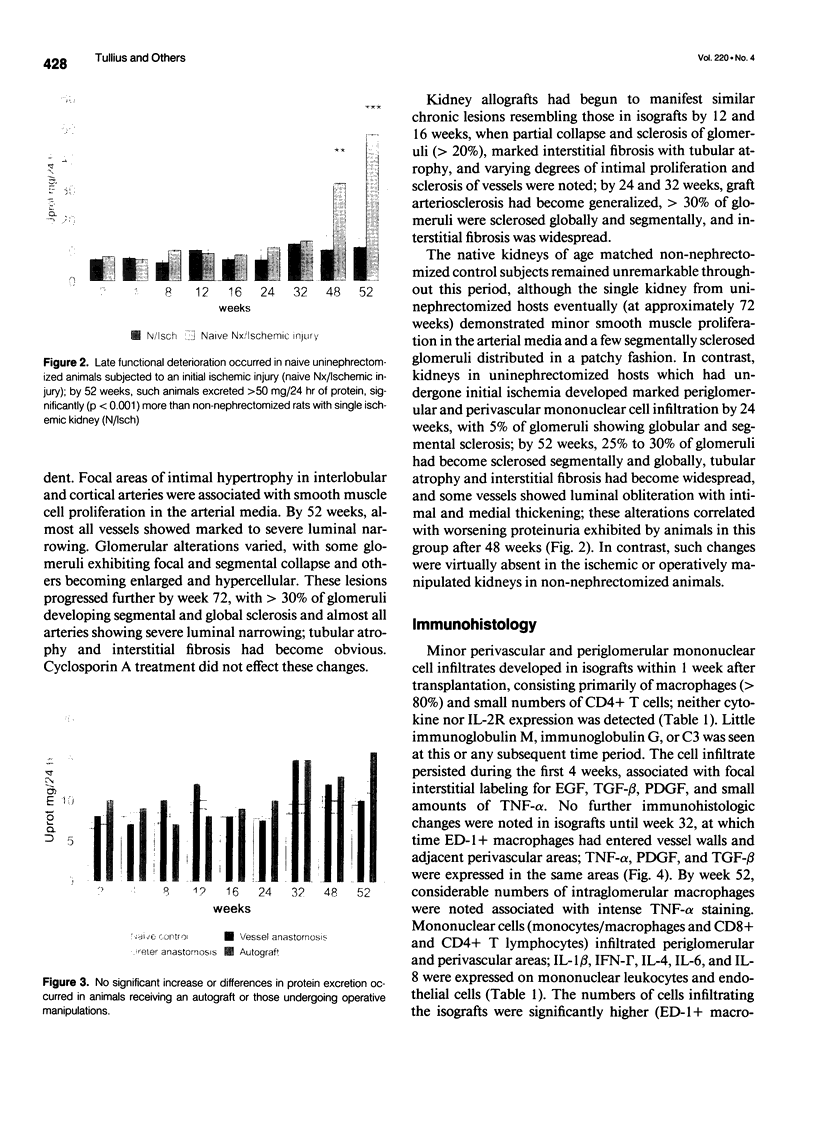
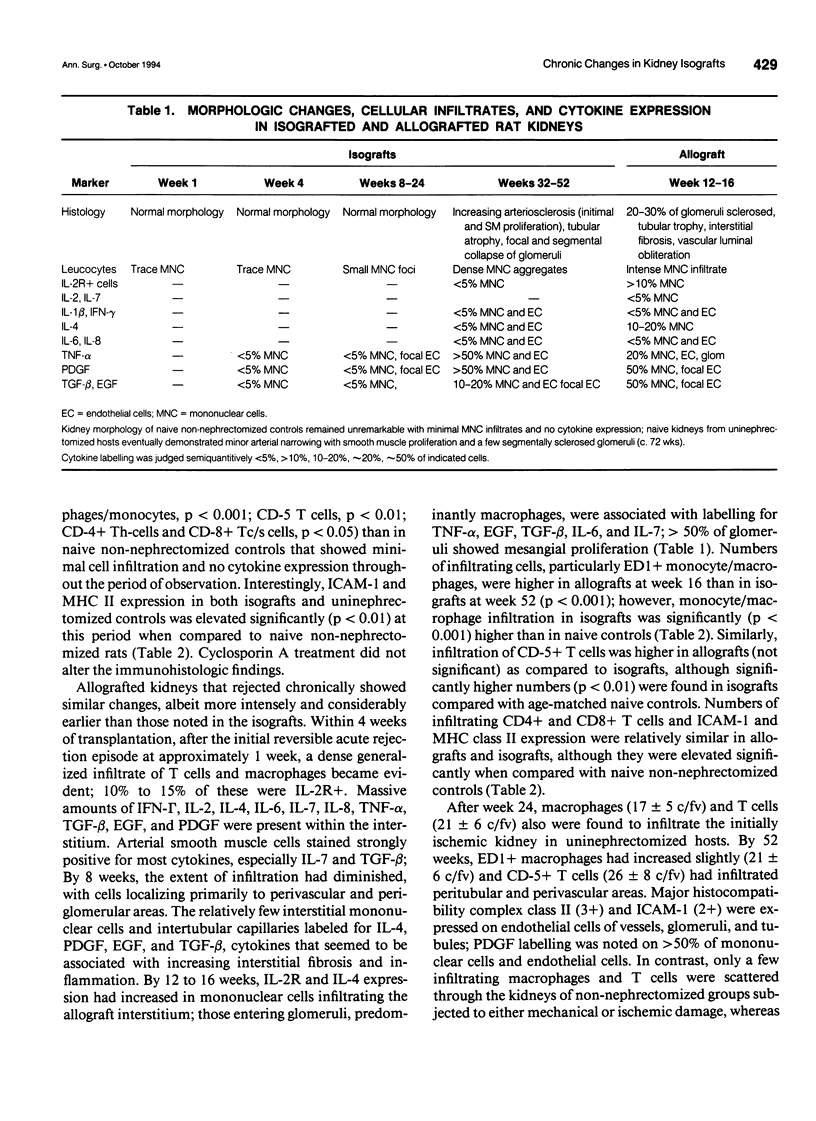
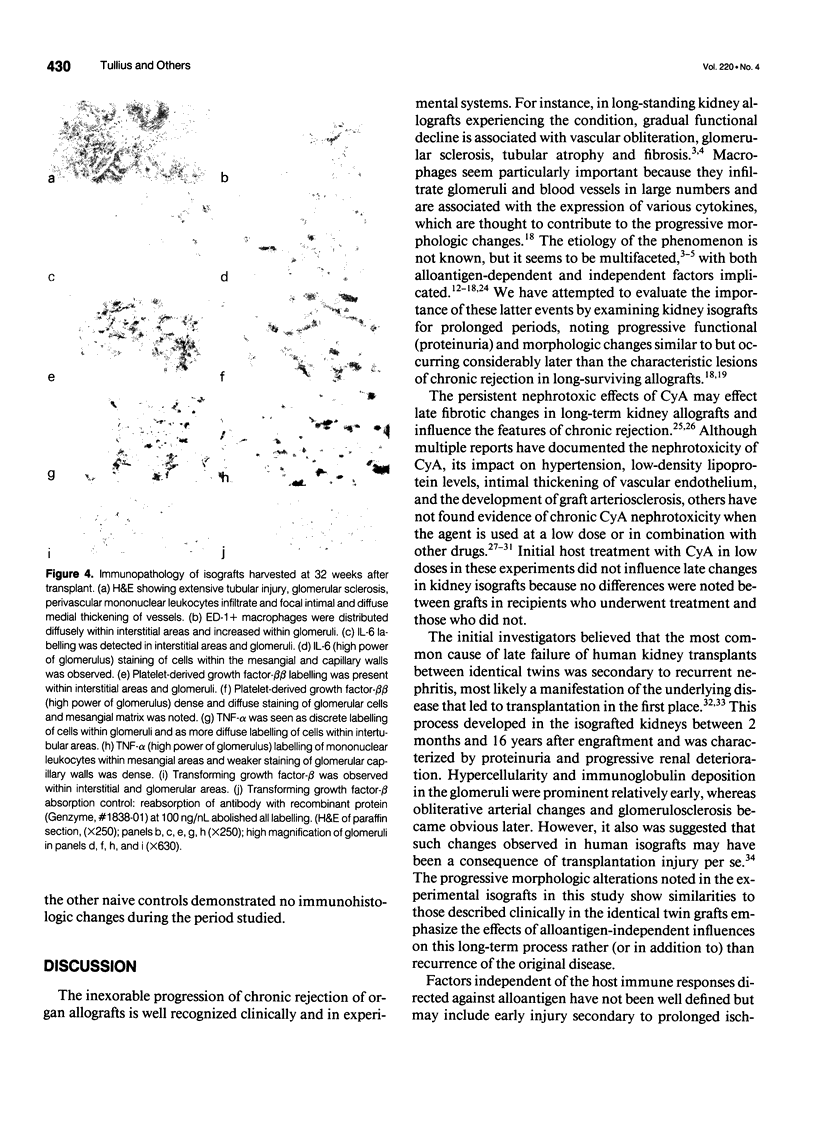
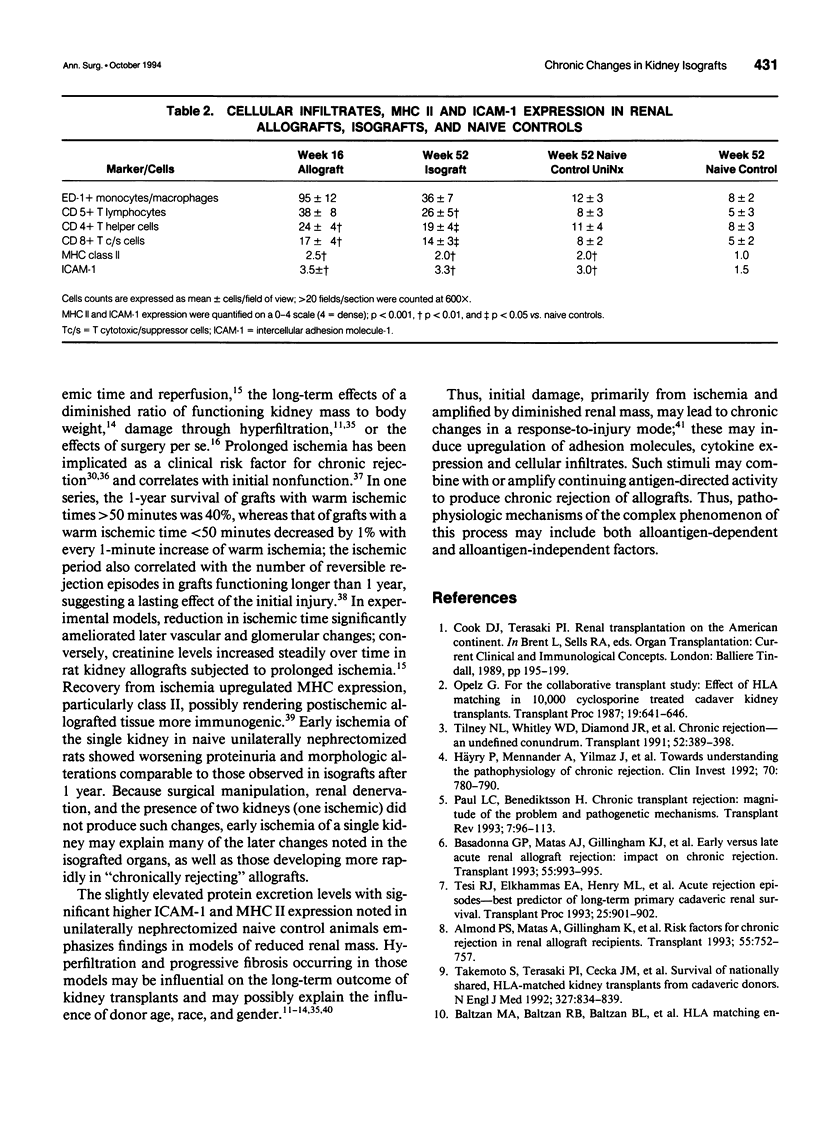
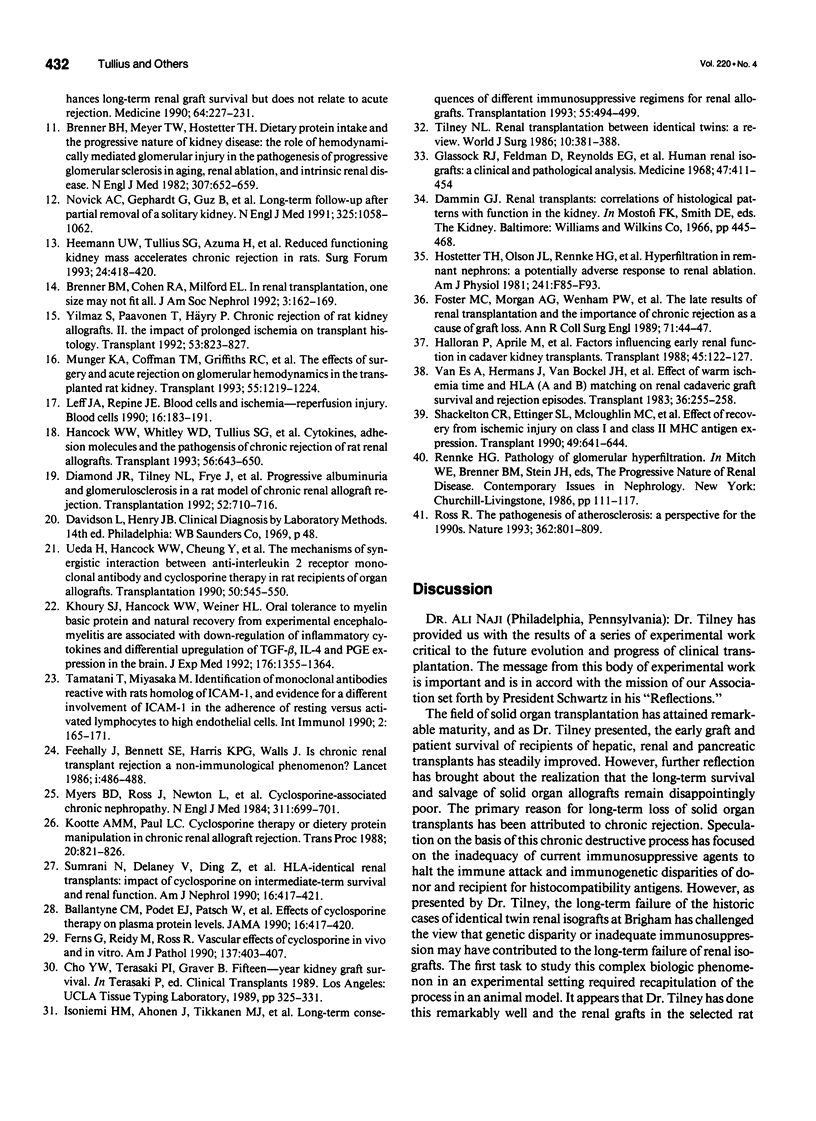
Images in this article
Selected References
These references are in PubMed. This may not be the complete list of references from this article.
- Almond P. S., Matas A., Gillingham K., Dunn D. L., Payne W. D., Gores P., Gruessner R., Najarian J. S. Risk factors for chronic rejection in renal allograft recipients. Transplantation. 1993 Apr;55(4):752–757. doi: 10.1097/00007890-199304000-00013. [DOI] [PubMed] [Google Scholar]
- Baltzan M. A., Baltzan R. B., Baltzan B. L., Cunningham T. C., Pylypchuk G. B., Dyck R. F., West M. L. HLA matching enhances long-term renal graft survival but does not relate to acute rejection. Medicine (Baltimore) 1990 Jul;69(4):227–231. doi: 10.1097/00005792-199007000-00004. [DOI] [PubMed] [Google Scholar]
- Basadonna G. P., Matas A. J., Gillingham K. J., Payne W. D., Dunn D. L., Sutherland D. E., Gores P. F., Gruessner R. W., Najarian J. S. Early versus late acute renal allograft rejection: impact on chronic rejection. Transplantation. 1993 May;55(5):993–995. doi: 10.1097/00007890-199305000-00007. [DOI] [PubMed] [Google Scholar]
- Brenner B. M., Cohen R. A., Milford E. L. In renal transplantation, one size may not fit all. J Am Soc Nephrol. 1992 Aug;3(2):162–169. doi: 10.1681/ASN.V32162. [DOI] [PubMed] [Google Scholar]
- Brenner B. M., Meyer T. W., Hostetter T. H. Dietary protein intake and the progressive nature of kidney disease: the role of hemodynamically mediated glomerular injury in the pathogenesis of progressive glomerular sclerosis in aging, renal ablation, and intrinsic renal disease. N Engl J Med. 1982 Sep 9;307(11):652–659. doi: 10.1056/NEJM198209093071104. [DOI] [PubMed] [Google Scholar]
- Diamond J. R., Tilney N. L., Frye J., Ding G., McElroy J., Pesek-Diamond I., Yang H. Progressive albuminuria and glomerulosclerosis in a rat model of chronic renal allograft rejection. Transplantation. 1992 Oct;54(4):710–716. doi: 10.1097/00007890-199210000-00028. [DOI] [PubMed] [Google Scholar]
- Feehally J., Harris K. P., Bennett S. E., Walls J. Is chronic renal transplant rejection a non-immunological phenomenon? Lancet. 1986 Aug 30;2(8505):486–488. doi: 10.1016/s0140-6736(86)90359-4. [DOI] [PubMed] [Google Scholar]
- Ferns G., Reidy M., Ross R. Vascular effects of cyclosporine A in vivo and in vitro. Am J Pathol. 1990 Aug;137(2):403–413. [PMC free article] [PubMed] [Google Scholar]
- Foster M. C., Wenham P. W., Rowe P. A., Burden R. P., Morgan A. G., Cotton R. E., Blamey R. W. The late results of renal transplantation and the importance of chronic rejection as a cause of graft loss. Ann R Coll Surg Engl. 1989 Jan;71(1):44–47. [PMC free article] [PubMed] [Google Scholar]
- Glassock R. J., Feldman D., Reynolds E. S., Dammin G. J., Merrill J. P. Human renal isografts: a clinical and pathologic analysis. Medicine (Baltimore) 1968 Sep;47(5):411–454. doi: 10.1097/00005792-196809000-00002. [DOI] [PubMed] [Google Scholar]
- Halloran P., Aprile M. Factors influencing early renal function in cadaver kidney transplants. A case-control study. Transplantation. 1988 Jan;45(1):122–127. doi: 10.1097/00007890-198801000-00027. [DOI] [PubMed] [Google Scholar]
- Hancock W. H., Whitley W. D., Tullius S. G., Heemann U. W., Wasowska B., Baldwin W. M., 3rd, Tilney N. L. Cytokines, adhesion molecules, and the pathogenesis of chronic rejection of rat renal allografts. Transplantation. 1993 Sep;56(3):643–650. doi: 10.1097/00007890-199309000-00028. [DOI] [PubMed] [Google Scholar]
- Hostetter T. H., Olson J. L., Rennke H. G., Venkatachalam M. A., Brenner B. M. Hyperfiltration in remnant nephrons: a potentially adverse response to renal ablation. Am J Physiol. 1981 Jul;241(1):F85–F93. doi: 10.1152/ajprenal.1981.241.1.F85. [DOI] [PubMed] [Google Scholar]
- Häyry P., Mennander A., Yilmaz S., Ustinov J., Räisänen A., Miettinen A., Lautenschlager I., Lemström K., Bruggeman C. A., Paavonen T. Towards understanding the pathophysiology of chronic rejection. Clin Investig. 1992 Sep;70(9):780–790. doi: 10.1007/BF00180748. [DOI] [PubMed] [Google Scholar]
- Isoniemi H. M., Ahonen J., Tikkanen M. J., von Willebrand E. O., Krogerus L., Eklund B. H., Höckerstedt K. V., Salmela K. E., Häyry P. J. Long-term consequences of different immunosuppressive regimens for renal allografts. Transplantation. 1993 Mar;55(3):494–499. doi: 10.1097/00007890-199303000-00008. [DOI] [PubMed] [Google Scholar]
- Khoury S. J., Hancock W. W., Weiner H. L. Oral tolerance to myelin basic protein and natural recovery from experimental autoimmune encephalomyelitis are associated with downregulation of inflammatory cytokines and differential upregulation of transforming growth factor beta, interleukin 4, and prostaglandin E expression in the brain. J Exp Med. 1992 Nov 1;176(5):1355–1364. doi: 10.1084/jem.176.5.1355. [DOI] [PMC free article] [PubMed] [Google Scholar]
- Kootte A. M., Paul L. C. Cyclosporine therapy or dietary protein manipulation in chronic renal allograft rejection. Transplant Proc. 1988 Jun;20(3 Suppl 3):821–826. [PubMed] [Google Scholar]
- Leff J. A., Repine J. E. Blood cells and ischemia-reperfusion injury. Blood Cells. 1990;16(1):183–192. [PubMed] [Google Scholar]
- Munger K. A., Coffman T. M., Griffiths R. C., Fogo A., Badr K. F. The effects of surgery and acute rejection on glomerular hemodynamics in the transplanted rat kidney. Transplantation. 1993 Jun;55(6):1219–1224. doi: 10.1097/00007890-199306000-00003. [DOI] [PubMed] [Google Scholar]
- Myers B. D., Ross J., Newton L., Luetscher J., Perlroth M. Cyclosporine-associated chronic nephropathy. N Engl J Med. 1984 Sep 13;311(11):699–705. doi: 10.1056/NEJM198409133111103. [DOI] [PubMed] [Google Scholar]
- Novick A. C., Gephardt G., Guz B., Steinmuller D., Tubbs R. R. Long-term follow-up after partial removal of a solitary kidney. N Engl J Med. 1991 Oct 10;325(15):1058–1062. doi: 10.1056/NEJM199110103251502. [DOI] [PubMed] [Google Scholar]
- Opelz G. Effect of HLA matching in 10,000 cyclosporine-treated cadaver kidney transplants. Transplant Proc. 1987 Feb;19(1 Pt 1):641–646. [PubMed] [Google Scholar]
- Ross R. The pathogenesis of atherosclerosis: a perspective for the 1990s. Nature. 1993 Apr 29;362(6423):801–809. doi: 10.1038/362801a0. [DOI] [PubMed] [Google Scholar]
- Shackleton C. R., Ettinger S. L., McLoughlin M. G., Scudamore C. H., Miller R. R., Keown P. A. Effect of recovery from ischemic injury on class I and class II MHC antigen expression. Transplantation. 1990 Mar;49(3):641–644. [PubMed] [Google Scholar]
- Sumrani N., Delaney V., Ding Z. K., Butt K., Hong J. HLA-identical renal transplants: impact of cyclosporine on intermediate-term survival and renal function. Am J Kidney Dis. 1990 Nov;16(5):417–422. doi: 10.1016/s0272-6386(12)80053-9. [DOI] [PubMed] [Google Scholar]
- Takemoto S., Terasaki P. I., Cecka J. M., Cho Y. W., Gjertson D. W. Survival of nationally shared, HLA-matched kidney transplants from cadaveric donors. The UNOS Scientific Renal Transplant Registry. N Engl J Med. 1992 Sep 17;327(12):834–839. doi: 10.1056/NEJM199209173271202. [DOI] [PubMed] [Google Scholar]
- Tamatani T., Miyasaka M. Identification of monoclonal antibodies reactive with the rat homolog of ICAM-1, and evidence for a differential involvement of ICAM-1 in the adherence of resting versus activated lymphocytes to high endothelial cells. Int Immunol. 1990;2(2):165–171. doi: 10.1093/intimm/2.2.165. [DOI] [PubMed] [Google Scholar]
- Tesi R. J., Elkhammas E. A., Henry M. L., Davies E. A., Salazar A., Ferguson R. M. Acute rejection episodes: best predictor of long-term primary cadaveric renal transplant survival. Transplant Proc. 1993 Feb;25(1 Pt 2):901–902. [PubMed] [Google Scholar]
- Tilney N. L. Renal transplantation between identical twins: a review. World J Surg. 1986 Jun;10(3):381–388. doi: 10.1007/BF01655297. [DOI] [PubMed] [Google Scholar]
- Tilney N. L., Whitley W. D., Diamond J. R., Kupiec-Weglinski J. W., Adams D. H. Chronic rejection--an undefined conundrum. Transplantation. 1991 Sep;52(3):389–398. doi: 10.1097/00007890-199109000-00001. [DOI] [PubMed] [Google Scholar]
- Ueda H., Hancock W. W., Cheung Y. C., Diamantstein T., Tilney N. L., Kupiec-Weglinski J. W. The mechanism of synergistic interaction between anti-interleukin 2 receptor monoclonal antibody and cyclosporine therapy in rat recipients of organ allografts. Transplantation. 1990 Oct;50(4):545–550. doi: 10.1097/00007890-199010000-00002. [DOI] [PubMed] [Google Scholar]
- Yilmaz S., Paavonen T., Häyry P. Chronic rejection of rat renal allografts. II. The impact of prolonged ischemia time on transplant histology. Transplantation. 1992 Apr;53(4):823–827. doi: 10.1097/00007890-199204000-00023. [DOI] [PubMed] [Google Scholar]
- van Es A., Hermans J., van Bockel J. H., Persijn G. G., van Hooff J. P., de Graeff J. Effect of warm ischemia time and HLA (A and B) matching on renal cadaveric graft survival and rejection episodes. Transplantation. 1983 Sep;36(3):255–258. doi: 10.1097/00007890-198309000-00006. [DOI] [PubMed] [Google Scholar]



